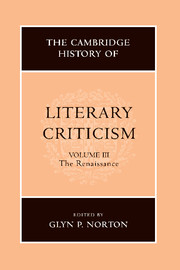Book contents
- Frontmatter
- Introduction
- READING AND INTERPRETATION: AN EMERGING DISCOURSE OF POETICS
- POETICS
- THEORIES OF PROSE FICTION
- CONTEXTS OF CRITICISM: METROPOLITAN CULTURE AND SOCIO-LITERARY ENVIRONMENTS
- VOICES OF DISSENT
- 40 The Ciceronian controversy
- 41 Reorganizing the encyclopaedia: Vives and Ramus on Aristotle and the scholastics
- 42 The rise of the vernaculars
- 43 Ancients and Moderns: France
- 44 Women as auctores in early modern Europe
- STRUCTURES OF THOUGHT
- NEOCLASSICAL ISSUES: BEAUTY, JUDGEMENT, PERSUASION, POLEMICS
- A SURVEY OF NATIONAL DEVELOPMENTS
- Bibliography
- Index
- References
41 - Reorganizing the encyclopaedia: Vives and Ramus on Aristotle and the scholastics
from VOICES OF DISSENT
Published online by Cambridge University Press: 28 March 2008
- Frontmatter
- Introduction
- READING AND INTERPRETATION: AN EMERGING DISCOURSE OF POETICS
- POETICS
- THEORIES OF PROSE FICTION
- CONTEXTS OF CRITICISM: METROPOLITAN CULTURE AND SOCIO-LITERARY ENVIRONMENTS
- VOICES OF DISSENT
- 40 The Ciceronian controversy
- 41 Reorganizing the encyclopaedia: Vives and Ramus on Aristotle and the scholastics
- 42 The rise of the vernaculars
- 43 Ancients and Moderns: France
- 44 Women as auctores in early modern Europe
- STRUCTURES OF THOUGHT
- NEOCLASSICAL ISSUES: BEAUTY, JUDGEMENT, PERSUASION, POLEMICS
- A SURVEY OF NATIONAL DEVELOPMENTS
- Bibliography
- Index
- References
Summary
In Ideology and utopia (1936), the sociologist Karl Mannheim regarded the breakup of the medieval Church as the historical condition of the emergence of a new professional class, the intelligentsia, which served the emerging political structures of early modern Europe. That class, of which Juan Luis Vives and Peter Ramus were among the most influential members, was to a great extent encompassed by thinkers that have come to be known as Renaissance humanists, whose principal intellectual impact was to replace the philosophically orientated logical arts of late medieval scholasticism with literary arts dominated by rhetoric. Both Vives and Ramus played a major role in this transformation. To use Peter Sharratt's phrase, their goal was to reorganize the encyclopaedia of the arts. Their lingering appeal to Aristotle on a host of matters notwithstanding, both considered themselves to be engaged in an advance guard intellectual reformation of great proportions that to some extent depended on an assault against Aristotle, the authority of the academic and intellectual establishment of the late Middle Ages – an Aristotle understood in the particular way he was institutionalized by scholastic thinkers. This contest of ideas took place within academic institutions; the stakes were intellectual influence on the newly emerging social and political formations.
Juan Luis Vives's own early education was firmly within this scholastic mould. As he became exposed to humanistic attitudes, he reacted strongly against the dominion of logic over language, an early indication that language teaching and language theory were to become the centre of gravity of his thought.
- Type
- Chapter
- Information
- The Cambridge History of Literary Criticism , pp. 402 - 408Publisher: Cambridge University PressPrint publication year: 1999



